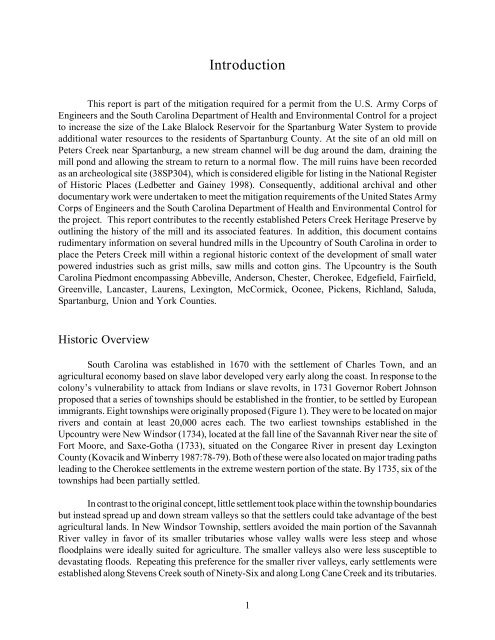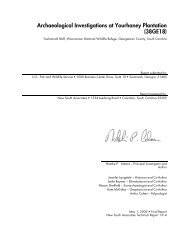Mills in the Upcountry: a Historic Context, and a Summary of a Mill ...
Mills in the Upcountry: a Historic Context, and a Summary of a Mill ...
Mills in the Upcountry: a Historic Context, and a Summary of a Mill ...
Create successful ePaper yourself
Turn your PDF publications into a flip-book with our unique Google optimized e-Paper software.
Introduction<br />
This report is part <strong>of</strong> <strong>the</strong> mitigation required for a permit from <strong>the</strong> U.S. Army Corps <strong>of</strong><br />
Eng<strong>in</strong>eers <strong>and</strong> <strong>the</strong> South Carol<strong>in</strong>a Department <strong>of</strong> Health <strong>and</strong> Environmental Control for a project<br />
to <strong>in</strong>crease <strong>the</strong> size <strong>of</strong> <strong>the</strong> Lake Blalock Reservoir for <strong>the</strong> Spartanburg Water System to provide<br />
additional water resources to <strong>the</strong> residents <strong>of</strong> Spartanburg County. At <strong>the</strong> site <strong>of</strong> an old mill on<br />
Peters Creek near Spartanburg, a new stream channel will be dug around <strong>the</strong> dam, dra<strong>in</strong><strong>in</strong>g <strong>the</strong><br />
mill pond <strong>and</strong> allow<strong>in</strong>g <strong>the</strong> stream to return to a normal flow. The mill ru<strong>in</strong>s have been recorded<br />
as an archeological site (38SP304), which is considered eligible for list<strong>in</strong>g <strong>in</strong> <strong>the</strong> National Register<br />
<strong>of</strong> <strong>Historic</strong> Places (Ledbetter <strong>and</strong> Ga<strong>in</strong>ey 1998). Consequently, additional archival <strong>and</strong> o<strong>the</strong>r<br />
documentary work were undertaken to meet <strong>the</strong> mitigation requirements <strong>of</strong> <strong>the</strong> United States Army<br />
Corps <strong>of</strong> Eng<strong>in</strong>eers <strong>and</strong> <strong>the</strong> South Carol<strong>in</strong>a Department <strong>of</strong> Health <strong>and</strong> Environmental Control for<br />
<strong>the</strong> project. This report contributes to <strong>the</strong> recently established Peters Creek Heritage Preserve by<br />
outl<strong>in</strong><strong>in</strong>g <strong>the</strong> history <strong>of</strong> <strong>the</strong> mill <strong>and</strong> its associated features. In addition, this document conta<strong>in</strong>s<br />
rudimentary <strong>in</strong>formation on several hundred mills <strong>in</strong> <strong>the</strong> <strong>Upcountry</strong> <strong>of</strong> South Carol<strong>in</strong>a <strong>in</strong> order to<br />
place <strong>the</strong> Peters Creek mill with<strong>in</strong> a regional historic context <strong>of</strong> <strong>the</strong> development <strong>of</strong> small water<br />
powered <strong>in</strong>dustries such as grist mills, saw mills <strong>and</strong> cotton g<strong>in</strong>s. The <strong>Upcountry</strong> is <strong>the</strong> South<br />
Carol<strong>in</strong>a Piedmont encompass<strong>in</strong>g Abbeville, Anderson, Chester, Cherokee, Edgefield, Fairfield,<br />
Greenville, Lancaster, Laurens, Lex<strong>in</strong>gton, McCormick, Oconee, Pickens, Richl<strong>and</strong>, Saluda,<br />
Spartanburg, Union <strong>and</strong> York Counties.<br />
<strong>Historic</strong> Overview<br />
South Carol<strong>in</strong>a was established <strong>in</strong> 1670 with <strong>the</strong> settlement <strong>of</strong> Charles Town, <strong>and</strong> an<br />
agricultural economy based on slave labor developed very early along <strong>the</strong> coast. In response to <strong>the</strong><br />
colony’s vulnerability to attack from Indians or slave revolts, <strong>in</strong> 1731 Governor Robert Johnson<br />
proposed that a series <strong>of</strong> townships should be established <strong>in</strong> <strong>the</strong> frontier, to be settled by European<br />
immigrants. Eight townships were orig<strong>in</strong>ally proposed (Figure 1). They were to be located on major<br />
rivers <strong>and</strong> conta<strong>in</strong> at least 20,000 acres each. The two earliest townships established <strong>in</strong> <strong>the</strong><br />
<strong>Upcountry</strong> were New W<strong>in</strong>dsor (1734), located at <strong>the</strong> fall l<strong>in</strong>e <strong>of</strong> <strong>the</strong> Savannah River near <strong>the</strong> site <strong>of</strong><br />
Fort Moore, <strong>and</strong> Saxe-Gotha (1733), situated on <strong>the</strong> Congaree River <strong>in</strong> present day Lex<strong>in</strong>gton<br />
County (Kovacik <strong>and</strong> W<strong>in</strong>berry 1987:78-79). Both <strong>of</strong> <strong>the</strong>se were also located on major trad<strong>in</strong>g paths<br />
lead<strong>in</strong>g to <strong>the</strong> Cherokee settlements <strong>in</strong> <strong>the</strong> extreme western portion <strong>of</strong> <strong>the</strong> state. By 1735, six <strong>of</strong> <strong>the</strong><br />
townships had been partially settled.<br />
In contrast to <strong>the</strong> orig<strong>in</strong>al concept, little settlement took place with<strong>in</strong> <strong>the</strong> township boundaries<br />
but <strong>in</strong>stead spread up <strong>and</strong> down stream valleys so that <strong>the</strong> settlers could take advantage <strong>of</strong> <strong>the</strong> best<br />
agricultural l<strong>and</strong>s. In New W<strong>in</strong>dsor Township, settlers avoided <strong>the</strong> ma<strong>in</strong> portion <strong>of</strong> <strong>the</strong> Savannah<br />
River valley <strong>in</strong> favor <strong>of</strong> its smaller tributaries whose valley walls were less steep <strong>and</strong> whose<br />
floodpla<strong>in</strong>s were ideally suited for agriculture. The smaller valleys also were less susceptible to<br />
devastat<strong>in</strong>g floods. Repeat<strong>in</strong>g this preference for <strong>the</strong> smaller river valleys, early settlements were<br />
established along Stevens Creek south <strong>of</strong> N<strong>in</strong>ety-Six <strong>and</strong> along Long Cane Creek <strong>and</strong> its tributaries.<br />
1







